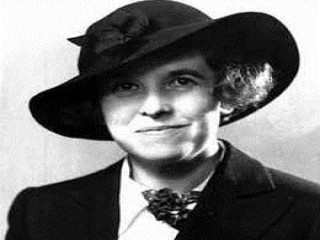
Hallie Flanagan biography
Date of birth : 1890-08-27
Date of death : 1969-07-23
Birthplace : Redfield, South Dakota
Nationality : American
Category : Famous Figures
Last modified : 2011-05-31
Credited as : Theatrical producer and director, playwright,
Hallie Flanagan was a director, playwright, and educator who headed the Federal Theater Project, America's first national, federally-funded theater organization, from 1935 to 1939.
Born in South Dakota on August 27, 1890, and raised in Iowa, Hallie Flanagan attended Grinnell College where she subsequently taught drama. She first gained notice as a playwright when she won a regional contest sponsored by the Des Moines Little Theatre Society with her play The Curtain. Her successful productions at Grinnell College eventually led her in 1923 to a position as production assistant in Professor George Pierce Baker's creative Workshop 47 at Harvard University, where she also completed a Master's degree. Returning to Grinnell, she directed for its experimental theater. Her productions there continued to win her recognition as an innovative director and led to her appointment as professor of drama and director of the experimental theater at Vassar College in 1925. A year later she received a prestigious honor—a grant from the Guggenheim Foundation (the first to be awarded to a woman).
On the Guggenheim fellowship Flanagan travelled to Europe and the U.S.S.R. to observe the exciting new developments on the continental stage of the early 1920s and wrote of her experiences in Shifting Scenes of the Modern European Theatre (1928). Besides being stimulated by the modernist experiments in staging that she saw in Europe, Flanagan was also strongly influenced by European dramatic forms and themes steeped in folklore, mythology, and history—the classic theater of Greece, popular puppet shows, robust folk plays, expansive verse dramas. In particular, the theaters of the Russian directors Vsevolod Meyerhold and Alexander Tairov impressed Flanagan with their vitality and strength and solidified her own goals to create theater that truly responded to and challenged its audience.
Returning to Vassar in 1926, Flanagan began to put these varied ideas and influences into practice and to build Vassar Theatre's reputation as one of the nation's leading experimental stages. The repertoire at the theater was richly diverse, ranging from contemporary plays dealing with current topics to experiments in form to classic texts daringly reinterpreted for the present. One of Flanagan's most celebrated productions was Can You Hear Their Voices? (1931). Co-authored by Flanagan and Margaret Ellen Clifford, the play was a carefully documented dramatization of a recent Arkansas drought that was controversial in both form and content as it revealed a rural world of hunger and privation neglected by governmental bureaucracy. Flanagan remained at Vassar until 1942, at which time she left for a similar teaching and directing position at Smith College in Massachusetts. She retired from academia in 1955.
Undoubtedly, Flanagan's greatest contribution to American theater was as director of the Federal Theater Project from 1935 to 1939. As a program of the Works Progress Administration, the Federal Theater Project was the first nation-wide, federally-sponsored theater in the United States. It was created to provide employment to professional theater artists in socially useful jobs during a time of severe economic depression. Committed to theater that serves as a dynamic artistic and social force for people, Flanagan sought to make the Federal Theater Project a regionally-rooted, popular, educational art theater that reached the entire nation. In many respects, Flanagan succeeded.
At its peak the Federal Theater employed over 10,000 people; operated theaters in 40 states; published a nationally distributed theater magazine; conducted a play and research bureau that served not only its own theaters but 20,000 schools, churches, and community theaters throughout the country; charged admission for less than 35 percent of its performances; and played to audiences totalling many millions.
Flanagan organized an ambitious program of classic and modern plays, dance drama, musical comedy, children's plays, religious plays, marionette shows, and series of plays by established playwrights and by young, new dramatists. Critical reaction to the artistic quality of the project's work grew increasingly positive beginning in 1936.
One of the Federal Theater's major achievements was the Living Newspaper, a compact, cinematic production style that dramatized immediate social and economic issues such as agriculture, flood control, and housing. Triple A Plowed Under, Power, and One-Third of a Nation represent pioneer productions in this art form.
Other important programs of the project included the development of a Black theater which presented significant productions of Macbeth, Haiti, and The Swing Mikado; classical revivals of miracle and morality plays and numerous Elizabethan productions; an international cycle of plays from Euripides to Ibsen; simultaneous production in 21 cities of Sinclair Lewis' anti-Fascist It Can't Happen Here; nation-wide productions of plays by Elmer Rice, Eugene O'Neill, and George Bernard Shaw; and regional productions such as The Sun Rises in the Westin Los Angeles and The Lost Colonyin North Carolina which were specifically geared to speak to local concerns and history.
Following Flanagan's vision of theater as an arena for vital exchange between artists and audiences, the Federal Theater was clearly a people's theater addressing national and regional issues in powerful, dramatic terms. Indeed, its consistently candid questioning of economic policies, especially in the Living Newspapers, ultimately brought the project criticism from witnesses before the House Committee on Un-American Activities and before the subcommittee of the House Committee on Appropriations. Although all major film, stage, and radio organizations as well as many community and sponsoring agencies spoke in favor of the Federal Theater, the Congress heatedly debated the continuation of the project. The House voted to dissolve the theater; the Senate voted to maintain it. On June 30, 1939, the Federal Theater was ended by congressional action.
















